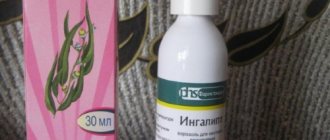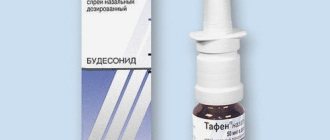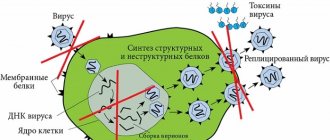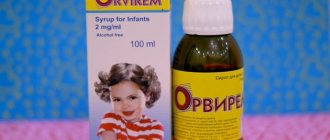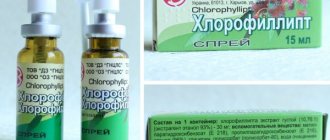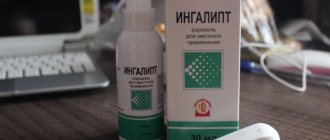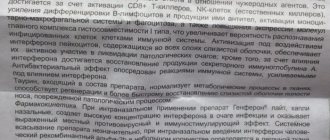Release form and composition
Oxyphrine is produced in the form of nasal drops 0.01%; dosed nasal spray 11.25 mcg/dose and dosed nasal spray 22.5 mcg/dose: drops and spray are a clear or almost transparent solution from colorless to light yellow (drops - 5 ml in bottles with a dosing device, in a cardboard pack 1 bottle; spray 10 ml (190 doses) in polyethylene bottles with a dispensing device, 10 ml (190 doses) or 15 ml (280 doses) in plastic bottles with a dispensing device, 1 bottle in a cardboard box).
Composition per 45 µl spray (11.25 µg/dose)/45 µl spray (22.5 µg/dose)/1 ml drops:
- active substance: oxymetazoline hydrochloride – 11.25/22.5/100 mcg;
- auxiliary components: anhydrous citric acid, sodium citrate dihydrate, anhydrous glycerol, water for injection.
How do Oxyfrin drops work?
The active substance is an alpha-adrenergic agonist, which acts on blood vessels and causes them to narrow. Due to this, swelling of the nasal mucosa is reduced and breathing improves. Oxymetazoline promotes the rapid removal of mucus, restores the level of air in the sinuses, thereby reducing the risk of developing bacterial infections, the occurrence of sinusitis, sinusitis, and inflammation of the middle ear.
After instilling drops into the nose in the dosage indicated in the instructions, it does not irritate the mucous membrane and does not cause redness. The action of the active substance begins a couple of minutes after use. Duration of action is up to 12 hours.
When Oxyphrine is instilled into the nose, no systemic effect is detected, that is, the drug acts only locally.
Pharmacological properties
Pharmacodynamics
Oxymetazoline is an alpha-agonist for topical use. When administered intranasally, it has a vasoconstrictive anticongestive effect, reduces swelling and nasal discharge, and helps facilitate nasal breathing.
Thanks to its action, the aeration of the paranasal sinuses improves, which in turn helps reduce the risk of bacterial complications such as sinusitis, sinusitis, and otitis media.
The use of Oxyfrin in recommended doses does not lead to irritation and hyperemia of the nasal mucosa.
The effect of the drug develops within a few minutes and lasts up to 12 hours.
Pharmacokinetics
When administered locally intranasally, oxymetazoline does not have a systemic effect. Its half-life (T1/2) in this case is 35 hours; 2.1% of the dose is excreted in the urine and 1.1% in feces.
Indications for use
The list of indications for the use of the medicinal composition includes various nasal breathing disorders for colds, inflammation of the nasal sinuses, eustachitis, hay fever, allergic rhinitis, congestion and swelling of the conjunctiva. The product is intended for local use only.
for adults
The drug Oxyfrin can be used by patients of this age category. The medication is well tolerated and does not cause adverse reactions. The active substance of the drug is not absorbed into the systemic circulation, so the drug can be effectively used by patients suffering from disorders of the liver and kidneys. Elderly people can also use the drug.
for children
The drug Oxyphrine can be used in pediatric practice without adjusting the dosage regimen. The drug is well tolerated by patients of this age category; no adverse reactions are observed during administration. The composition is recommended to be used in accordance with the regimen of use described by the attending physician. Failure to comply with the regimen may cause severe adverse reactions.
for pregnant women and during lactation
The use of the drug during pregnancy and breastfeeding is contraindicated. The medication can cause a woman’s well-being to deteriorate. The drug may have a negative effect on fetal development. When used during breastfeeding, a special dosage regimen should be followed or breastfeeding should be abandoned.
Contraindications
Absolute contraindications:
- atrophic rhinitis;
- angle-closure glaucoma;
- surgical operations on the dura mater (history);
- condition after transsphenoidal hypophysectomy;
- age up to 1 year (for spray 11.25 mcg/dose) and up to 6 years (for spray 22.5 mcg/dose);
- increased sensitivity to the components of the drug.
Relative contraindications:
- diseases of the cardiovascular system (coronary heart disease, arterial hypertension, chronic heart failure, severe atherosclerosis, arrhythmias, tachycardia);
- diabetes;
- hyperthyroidism;
- pheochromocytoma;
- chronic renal failure;
- prostatic hyperplasia with urinary retention;
- increased intraocular pressure;
- porphyria;
- taking monoamine oxidase inhibitors during the previous 2 weeks, and for 2 weeks after their withdrawal, bromocriptine, tricyclic antidepressants.
Instructions for use of Oxyfrin: method and dosage
The drug is used intranasally.
Oxyphrine for children under 1 year of age can only be used in the form of drops.
Children from 1 to 6 years old are prescribed 1 injection of Oxyphrine spray 11.25 mcg/dose into each nasal passage 2-3 times a day. Duration of treatment is 5–7 days. If a repeated course is necessary, the interval between them should be at least several days.
Children over 6 years of age and adults are prescribed 1 injection of Oxyphrine spray 22.5 mcg/dose into each nasal passage 2-3 times a day. The duration of use should not exceed 7 days.
If symptoms worsen or if the condition does not improve within 3 days, it is recommended to consult a doctor. Increasing the dose of Oxyfrin is permissible only with prescription and under the supervision of a physician.
Long-term and frequent use of the drug may cause the appearance or worsening of nasal congestion. In this case, you should stop treatment and consult a specialist.
Analogs
Other drugs intended for intranasal use and having similar pharmacological characteristics can be considered as analogues of the drug.
Afrin
The drug Afrin is a drug belonging to the group of vasoconstrictor drugs intended for local use. The medication is used to improve nasal breathing with a runny nose in children and adults over 6 years of age. The composition can be used by pregnant women and nursing mothers, which confirms its safety. The medication has a thick formula, which ensures its effect on the mucous membranes of the nose and prevents it from flowing into the throat. The product eliminates congestion and restores breathing for 12 hours.
Nazivin
The drug Nazivin is used to improve breathing and eliminate swelling of the nasal mucous membranes. The main active ingredient of the drug is oxymetazoline. The drug is produced in the form of nasal drops. The drug is indicated for use in rhinitis during respiratory diseases.
Sialor
The drug Sialor contains an active antiseptic. The product is used to treat diseases of the ENT organs; it is used for rinsing and instillation into the nasal cavity and ear. The drug promotes tissue healing and also creates a protective film on the mucous membranes. To achieve a therapeutic result, the drug is used in a limited course. The advantage of the drug is its safety. The drug can be used by children aged 2 months and older.
Rhinostop
The drug Rinostop is considered as an anticongestive drug. The drug belongs to the group of alpha adrenergic agonists. The drug can be used in children over 2 years of age and in nursing women. The product is produced in the form of a nasal spray with different dosages of the active substance.
Otrivin
The drug Otrivin complex is considered as a vasoconstrictor drug characterized by a pronounced effect. The drug is often prescribed to children. The composition in spray form is intended for adult patients. The drugs can be used during pregnancy in cases where the expected benefit to the mother outweighs the risks to the child or fetus.
Side effects
Local side effects: dryness of the nasopharyngeal mucosa, an increase in the volume of secretions discharged from the nose, sneezing, nosebleeds, a feeling of nasal congestion after the end of the drug.
Systemic side effects: headache, increased blood pressure (BP), dizziness, tachycardia, palpitations, anxiety, insomnia/drowsiness, fatigue, irritability, sleep disturbance in children, nausea, exanthema, blurred vision if the drug gets into the eyes, hallucinations, convulsions, Quincke's edema, respiratory arrest in infants.
With long-term use, atrophy or recurrent edema of the nasal mucosa and tachyphylaxis may develop.
You should consult a doctor if the described side effects worsen, or if new ones occur.
Interaction with other drugs
Avoid simultaneous use of the spray with drugs that have a vasoconstrictor effect. Their combination enhances the effect on the body and often leads to the development of side effects.
Oxyphrine should be used with caution in combination with the following medications:
- monoamine oxidase inhibitors;
- drugs designed to increase blood pressure;
- tricyclic antidepressants;
- local anesthetic medications.
In combination with them, oxymetazoline can greatly increase blood pressure, which manifests itself in rapid heartbeat, tinnitus, and facial flushing. When combining the active ingredients of the spray and anesthetics for local anesthesia, the absorption of the latter into the blood slows down. This leads to an increase in the duration of their action.
Overdose
Symptoms of Oxyphrine overdose: restlessness, anxiety, lethargy, drowsiness, decreased body temperature, constriction or dilation of the pupils, fever, pallor, sweating, palpitations, cyanosis, bradycardia, arrhythmia, increased or decreased blood pressure, nausea, vomiting, respiratory depression to the point of stopping , hallucinations, convulsions, coma, cardiac arrest.
It is recommended to lavage the stomach, take activated charcoal (in case of unintentional ingestion of the drug), and symptomatic therapy.
special instructions
Avoid contact of the drug with the eyes.
To prevent the spread of infection, it is recommended to use the drug individually.
Impact on the ability to drive vehicles and complex mechanisms
With long-term use of Oxyphrine in high doses, the development of undesirable effects on the cardiovascular and central nervous systems is possible, which requires caution when driving vehicles, other complex mechanisms and performing types of work that require rapid psychomotor reactions.
Conditions for dispensing from pharmacies, price of the drug
The drug does not contain strong active substances, so the patient does not require constant monitoring of the drug’s effect on his well-being by medical professionals. The medication can be purchased at any pharmacy and it is not necessary to have a prescription written by a doctor with you.
Despite this, it is recommended to visit a specialist before starting to use the spray. A professional pediatrician will examine the child and, after analyzing his condition, will be able to say exactly how safe and effective the drug will be in his case. It is especially important to see a doctor if children have chronic diseases.
The cost of the drug varies. It is influenced, first of all, by the city and the pharmacy where the purchase is made. As a rule, the larger the city, the more expensive the medicine there. Prices for Oxyfrin start at 95 rubles. and can reach up to 200 rubles.
